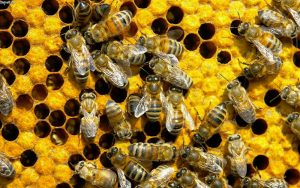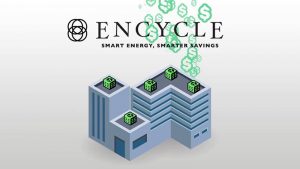Biomimicry might simply be described as “learning from nature,” but since biomimicry has many layers of simplicity and complexity, let’s preface this discussion with some context as to how biomimicry fits within the closely-related concepts of emergence theory and swarm intelligence.
Emergence theory, or simply “emergence,” can be described as a process whereby novel and coherent structures, patterns and properties arise during the phenomenon of self-organization that occurs spontaneously in complex systems. In explaining emergence, the terms macro-level and micro-level are often used, where the macro-level refers to the level at which novel emergent phenomena arise out of the components and processes occurring at the micro-level1.

More Than the Sum of the Parts….
Emergence is a natural phenomenon whereby larger entities arise through interactions among smaller or simpler entities such that the larger entities exhibit properties that are exhibited by none of its constituent, smaller entities. Termite “cathedral” mounds are often cited as one of numerous examples of emergence found in nature, characterized by organisms that communicate with each other by exchanging small bits of information frequently and which, over time and through mutations, evolve behaviors that are not only efficient for each organism, but more importantly, are effective for the collective’s survival. Decentralized decision making is a key aspect of such emergent systems, where no “master and slave” control structures are required and are, in fact, highly discouraged.
Emergence has also been applied to much more esoteric topics such as understanding the development of consciousness in brains2. Most scientists and philosophers generally agree that consciousness is not a property that is exhibited by any of the brain’s individual constituent neurons. Yet, when taken as a whole, brains in general–and human brains in particular–exhibit this mysterious phenomenon.
The Power of the Swarm and Self-Organizing Systems
This brings us to the notion of “swarm intelligence,” which is also often explained in terms of emergence theory. Examples of swarm intelligence abound in nature. Ants, bees, termites, geckos, sharks, flocking birds and buffalo herds… these are just a few examples. Surprisingly, even slime mold, which is composed of amoebae that have no “brains,” exhibits an elementary level of intelligence, such as learning to traverse a maze3. The life cycle complexity of the simple amoebae is a scientific curiosity that demonstrates the extremes of nature where swarm intelligence is exhibited.
It is interesting to speculate whether we humans, who are migrating rapidly to larger cities and becoming increasingly connected through the “cloud,” will eventually start exhibiting new and unexpected “swarm intelligence.” This could lead to some interesting consequences for the human species, whose brain size is a compromise between higher intelligence and the food necessary to support our larger brain size.
In fact, human brains are, for mammals of our body size, extraordinarily large, approximately three times the volume of those of chimpanzees and other great apes, the result of an enormous evolutionary expansion of the cerebral cortex during the past two million years. “If you want a big brain, you’ve got to feed it,” points out Todd Preuss of Emory University in Atlanta, Georgia.
If we find ourselves as individuals depending more and more on our swarm intelligence, while at the same time having less food to feed an expanding global population, human brain size may begin to decrease. Interestingly, there are some indications that this is already happening. The growth in the size of our brains actually ceased around 200,000 years ago, and in the past 10,000 to 15,000 years the average size of the human brain compared with our body has shrunk by three or four percent.
Some see this as no cause for concern. Size, after all, isn’t everything, and it’s perfectly possible that the brain has simply evolved to make more efficient use of its grey and white matter. Others, however, believe rather pessimistically that this shrinkage is a sign of a slight decline in our general mental abilities. David Geary at the University of Missouri-Columbia, for one, believes that as complex societies have developed, the less intelligent are beginning to survive on the backs of their smarter peers, whereas previously they would have died – at least before finding a mate.
Biomimicry: Imitation as a Science
So, let us now consider our entitled subject, “biomimicry.” As the word itself implies, biomimicry is the art and science of mimicking biological systems to our benefit – turning to nature and the processes of natural selection for fresh and creative ideas and solutions.
For those of us interested in the etymology of words, the term “biomimetics” was first introduced by the American biophysicist and mathematician Otto Schmitt, appearing in the title of a paper he published in 19695. By 1974 it had found its way into Webster’s Dictionary. Its derivative term “biomimicry” first appeared in the literature in a paper published in 1982 by Connie Merrill at Rice University6. Biomimicry was later popularized by scientist and author Janine Benyus in her 1997 book Biomimicry: Innovation Inspired by Nature. Benyus defines biomimicry as a “new science that studies nature’s models and then imitates or takes inspiration from these designs and processes to solve human problems.” Benyus suggests looking to nature as a “model, measure and mentor” and emphasizes sustainability as an objective of biomimicry.
Just Look Around You
To understand biomimicry, we don’t really need to understand how emergence or swarm intelligence produced the wonderfully evolved diversity of nature we see around us; we simply need to observe and apply what we see to solving problems. This could be as simple as a hunter mimicking a bird or animal call, or as complex as designing an airplane wing or a bridge.
Learning from the lessons of termites, lotus leaves, coral and honey bees, for example, we are creating everything from more resilient cities, to self-cleaning toilets, eco-friendly cement and energy-efficient air-conditioning systems.
Today there are numerous examples of the successful application of biomimetic principles to engineering problems. A biomimetic approach to problem solving can utilize any facet of biological systems. Examples include Velcro, originally inspired from thistles, and the honeycomb-based structure for aircraft, which was patented by Hugo Junkers in 1915.
Aerodynamic designs have traditionally relied on rather basic principles that emphasize smooth surfaces and sleek lines to maximize lift and minimize drag. However, many species throughout the animal kingdom exhibit shapes that depart from these traditional designs. The Humpback whale, for example, uses bumpy, tubercle fins for propulsion, which runs contrary to traditional hydrodynamic engineering principles. Tests conducted by the U.S. Naval Academy, using model flippers, determined these biomimetic fins reduce drag by nearly a third and improve lift by eight percent overall. Whale Power, a company based in Toronto, Canada, has already capitalized on this latest tubercle technology with biomimetic wind power blades, which purportedly generate the “same amount of power at 10 miles per hour that conventional turbines generate at 17 miles per hour.”
Biomimicry and Smarter, More Efficient Buildings
Applications of biomimicry principles to building facilities include examples such as the Eastgate Centre in Zimbabwe, which uses ducts and 48 huge chimneys to passively move hot daytime air out, and the Khoo Teck Puat hospital in Singapore, which includes fins that are built along the walls to channel prevailing winds into the building, thereby enhancing airflow by 20-30 percent.
Biomimicry also plays a key role in the concept and execution of “Living Buildings.” The Living Building Challenge is a green building certification program and sustainable design framework that uses the metaphor of a flower as its ideal because its goal is to create buildings that function as cleanly and efficiently as a flower. A flower creates its own energy from the sun. It collects the water it needs from moisture in its immediate environment, and it does not pollute. One such structure is the Betty and Clint Josey Pavilion, Texas.
The 5,000-square-foot pavilion is a site for meetings and educational events at the Dixon Water Foundation’s Leo Unit in Cooke County. The pavilion was completed in spring 2014, and starting October 1, 2014, the building began a one-year performance evaluation, after which the pavilion was granted certification as Texas’s first Living Building.

Honey Bees and HVAC Efficiency
Of particular interest to us at Encycle® is the application of biomimicry to building automation and control systems. A typical building automation system or “BAS” has a top-down structure with its “brain” located either on site, or connected remotely via the “cloud.” Its client devices and systems, such as lighting, HVAC and refrigeration are either “dumb” or “thin clients” that only respond to instructions transmitted from their control center.
In this paradigm, traditional BASs are the antithesis of swarms and swarm intelligence, which have no central control, and where each participant makes its own individual decisions using simple rules based on the rather limited information available to them. Of course, one can imagine a hybrid system where some degree of decision making is localized as in the swarm model, but with some direction from a central control having more information and more intelligence to process this larger information base. Choosing the best structure is a complex decision that depends on a lot of factors such as installation cost, scalability, robustness, maintainability and efficiency, to name a few.
Applying the biomimicry of honey bees to HVAC control creates a significant paradigm shift, moving from a top-down to a bottomup decision making control system that allows electrical loads to work independently, while at the same time communicating with – and learning from – each other to create simple, yet highly efficient algorithms through which each load understands how to operate efficiently as part of the larger group of rooftop units.
Self-Learning: Evolution at Work
In nature, the “control system” is a bee hive, where the queen bee does not instruct each bee, rather, each bee senses the pheromone trails of others and the hive’s environment, and makes decisions using algorithms evolved over millennia. These efficient decision algorithms are used continuously by each bee, making independent and autonomous decisions that are not only useful for each bee’s survival, but also beneficial for the hive’s survival. The analogy of replacing bees with electrical loads, which broadcasting wireless messages to each that are used to make load decisions of when to operate – and when to not operate – are not only good for each roof top unit, but also good for the building as a whole.
These attributes in fact pertain to HVAC systems with their plurality of roof top units or RTUs. Depending on the size of the building served, an HVAC system may comprise a handful or even scores of RTUs, each serving a particular zone in the system. While orchestrating the operation of dozens of RTUs might seem daunting in a centralized control system, the task becomes easier if each RTU is provided with just the minimum and sufficient intelligence necessary to know the optimum times to turn on and off.
To make prudent decisions, each RTU simply needs to know the conditions in the zone it serves and what decisions have been made or are pending for its neighboring RTUs. Encycle’s bio-inspired Swarm Logic® software can “swarm” and control rooftop units via devices that provide connectivity to these units via communication among small controllers installed on each RTU, using Wi-Fi thermostats or using cloud-based software APIs that enable control of RTUs via third-party building management and building automation systems. Its algorithms allow the controllers to make intelligent decisions on when to enable and disable their respective RTUs. In this case, copying the honey bee has resulted not only in reductions in peak demand and peak demand costs for building managers, but it has also reduced overall electrical bills by 15-25 percent, improved the overall performance of HVAC systems and cut maintenance time and costs.
Leveraging Nature’s Genius
Many years ago, Albert Einstein said, “If we look deep into nature, we will understand everything.” With new sustainability and energy savings benchmarks stretching from countries, to cities, to corporate board rooms and our individual homes, there is no shortage of demand for bio-inspired technology and no end in sight for how such technology can help improve our planet. We will continue to enhance our technology to achieve better results in an ever-growing population of buildings and envision the ongoing evolution of this bio-inspired control strategy as it continues its migration from the rooftop, to the thermostat, to the cloud and beyond.
We’ve only scratched the surface of nature’s infinite potential to provide solutions for a smarter, more sustainable energy future. To quote the previously mentioned biomimicry pioneer Janine Benyus, “When we stare this deeply into nature’s eyes, it takes our breath away, and in a good way, it bursts our bubble. We realize that all our inventions have already appeared in nature in a more elegant form and at a lot less cost to the planet.”
FOOTNOTES
1. Goldstein, J. (1999). Emergence as a Construct: History and Issues. Emergence, 1, 49-72.
2. Thompson, E. & Varela, F.J. (2001). Radical embodiment: neural dynamics and consciousness. Trends in Cognitive Sciences, 5, 418-425.
3. Jabr, F. (2012) Single-celled amoebae can remember, make decisions and anticipate change, urging scientists to rethink intelligent behavior. Scientific American, November 7, 2012
4. Bailey, D., Geary, D. (2009) Hominid Brain Evolution. Human Nature (2009) 20:67–79
5. Schmitt O. (1969). Some interesting and useful biomimetic transforms. Third Int. Biophysics Congress. p. 297.
6. Merrill, Connie Lange (1982). Biomimicry of the Dioxygen Active Site in the Copper Proteins Hemocyanin and Cytochrome Oxidase. Rice University.
7. Lewis, W. (2016) Mathematical model of a moment-less arch. Proc.R.Soc. A472:20160019.
Press Release by Encycle




